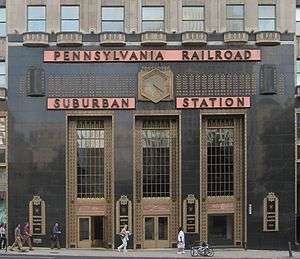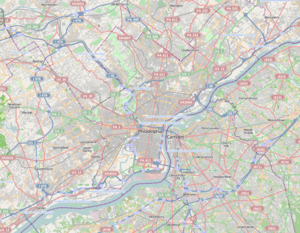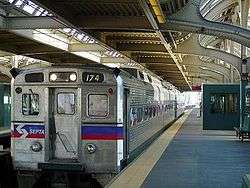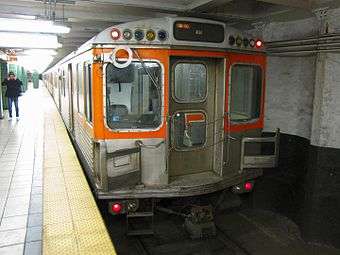Suburban Station
Suburban Station is an art deco office building and underground commuter rail station in Penn Center, Philadelphia. Its official SEPTA address is 16th Street and JFK Boulevard.[2] The station is owned and operated by SEPTA and is one of the three core Center City stations on the SEPTA Regional Rail. The station was built by the Pennsylvania Railroad to replace the original Broad Street Station and opened on September 28, 1930.
History
The station opened as a stub-end terminal for Pennsylvania Railroad trains serving Center City Philadelphia, intended to replace the above-ground Broad Street Station in this function. The station's full name was originally Broad Street Suburban Station. One Penn Center served as the headquarters of the PRR from 1930 to 1957.
From 1973 to 1981 Amtrak (the National Railroad Passenger Corporation) provided service to the station with its Silverliner Service. From 1973-1975 the Silverliner Service ran from Harrisburg to the North Philadelphia station.[3] In 1975, Silverliner service was extended to New York City. However, with the extension the routing was altered such that all trains would stop at the 30th Street Station both before and after stopping this station.[4] In 1981 the Silverliner Service was re-branded the Keystone Service.[5] Amtrak ended service to the station in 1988.[6]
Plans for a tunnel to link the Pennsylvania and Reading commuter lines were floated as early as the 1950s, but funding to seriously study the project did not start until the late 1960s. The project languished in the 1970s due to lack of funding until federal money was appropriated during Philadelphia mayor Frank Rizzo's time in office.
Suburban Station was originally a stub-end terminal station with 8 tracks and 4 platforms until 1984 when the Center City Commuter Connection project extended four of those tracks eastward to the new Market East Station (now Jefferson Station), widened two of the existing platforms, realigned the tracks and added a fifth platform. The recently renovated 21-story building above is also the core of the Penn Center office complex, and is known as One Penn Center at Suburban Station. The office building attained an Energy Star Rating in 2009.[7]
BLT Architects transformed Suburban Station in 2006. The station was redesigned to make navigation easier and adapt to current pedestrian traffic.[8] Upgrades included increased retail space, a reactivated and improved HVAC system, and a restored/refurbished waiting area. The station is now in full compliance with the Americans with Disabilities Act of 1990. The Comcast Center, situated on the north half of its block near Arch Street, adds a "winter garden" on the south side, which serves as a new back entrance to the station, with the commuter rail tracks about 50 feet below street level.
Services

All SEPTA Regional Rail trains stop at this station. All run through except those on the Cynwyd Line as well as some limited/express trains which terminate on one of the stub-end tracks at this station. Through trains usually change crews at this station.
The station has an extensive concourse level above track level. This concourse has SEPTA ticket offices, retail shops and restaurants, and access to other SEPTA stations and to several Center City buildings. The connections include the Broad Street Line at the City Hall station and the Market-Frankford Line and Subway-Surface Lines at the 15th Street station.
Station layout
| B1 | Concourse | Waiting area, ticketing, shops, exits, access to Market-Frankford Line, Broad Street Line & SEPTA Subway-Surface Trolley Lines |
| B2 Track level |
Track 0 | [Limited use] |
| Island platform, doors will open on the left, right | ||
| Track 1 | ← Manayunk/Norristown Line toward Norristown (Jefferson) ← Fox Chase Line toward Fox Chase (Jefferson) | |
| Island platform, doors will open on the left, right | ||
| Track 2 | ← Warminster Line toward Warminster (Jefferson) ← West Trenton Line toward West Trenton (Jefferson) | |
| Track 3 | Media/Elwyn Line toward Elwyn (30th Street Station)→ Wilmington/Newark Line toward Newark (30th Street Station)→ | |
| Island platform, doors will open on the left, right | ||
| Track 4 |
Trenton Line toward Trenton Transit Center (30th Street Station)→ | |
| Island platform, doors will open on the left, right | ||
| Track 5 | [Limited use] | |
| Track 6 |
Cynwyd Line toward Cynwyd (30th Street Station)→ | |
| Island platform, doors will open on the left, right | ||
| Track 7 |
Paoli/Thorndale Line express to/from Thorndale (30th Street Station)→ | |
References
- ↑ National Park Service (2007-01-23). "National Register Information System". National Register of Historic Places. National Park Service.
- ↑ SEPTA | Suburban Station
- ↑ Amtrak (29 Apr 1973). "Amtrak All-American Schedules". timetables.org. The Museum of Railway Timetables. p. 30. Retrieved 3 Jun 2014.
- ↑ Amtrak (30 Nov 1975). "All-American Schedules". timetables.org. The Museum of Railway Timetables. p. 30. Retrieved 3 Jun 2014.
- ↑ Amtrak (25 Oct 1987). "Amtrak National Train Timetables". timetables.org. The Museum of Railway Timetables. p. 22. Retrieved 3 Jun 2014.
- ↑ "History of US Passenger Train Inaugurations & Discontinuances". National Association of Railroad Passengers. Retrieved 20 Feb 2013.
- ↑ "Suburban Station". Emporis.com. Retrieved 8 May 2008.
- ↑ BLTa Architects: Suburban Station
External links
![]() Media related to Suburban Station (SEPTA) at Wikimedia Commons
Media related to Suburban Station (SEPTA) at Wikimedia Commons
- SEPTA - Suburban Station
- Pennsylvania Railroad - Suburban Station (Pennsylvania Railroad Stations; Past & Present)
- JFK Boulevard and 17th Street entrance from Google Maps Street View
- JFK Boulevard and 18th Street entrance from Google Maps Street View
- JFK Boulevard and 16th Street entrance from Google Maps Street View
- 16th Street entrance from Google Maps Street View
- Main entrance from Google Maps Street View
- JFK Boulevard and 15th Street entrance from Google Maps Street View










